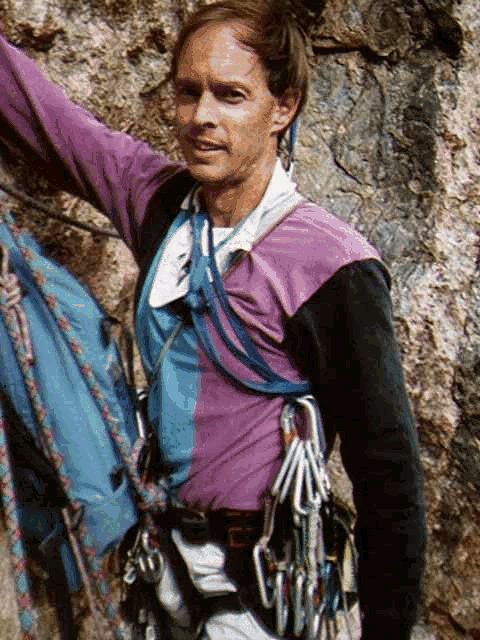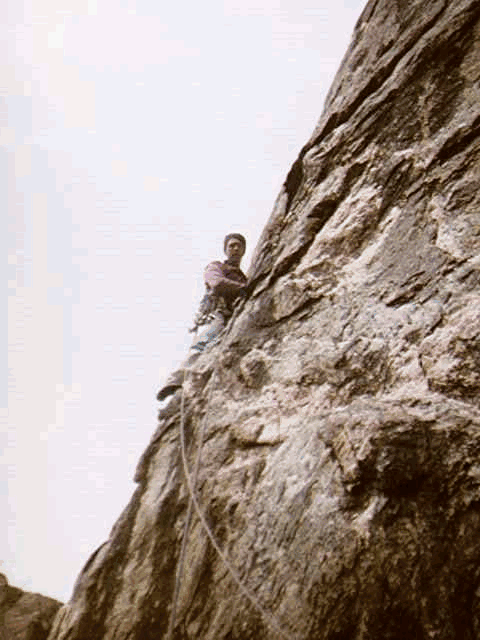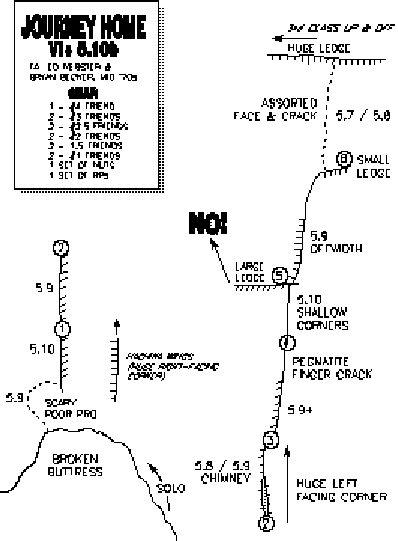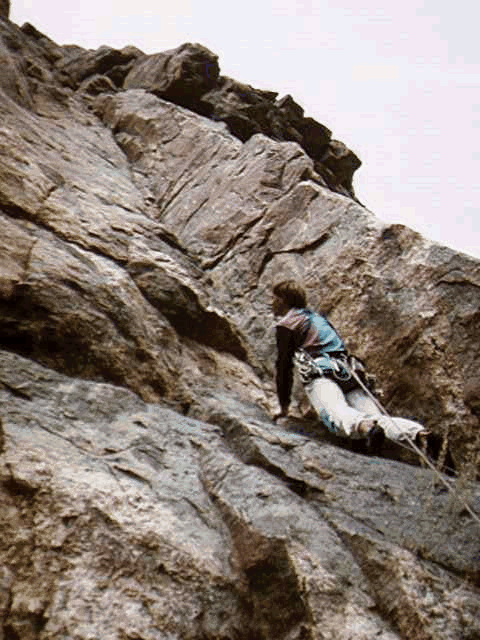The Black Canyon of the Gunnison is an intimidating place to climb. It is deep and dark and the climbs are loose and runout. And big. The Black Canyon holds the only Grade VI climbs in Colorado and includes the dangerous 2700 foot Painted Wall. Not surprisingly Layton Kor was one of the first climbers to significantly explore the Black Canyon, putting up a number of the classic routes on aid. Of the next generation of climbers, perhaps Ed Webster was the foremost practitioner, freeing old aid routes and establishing numerous free climbs.
Ed Webster is an incredibly diverse climber. He established, solo, what is considered to be the premier desert climb. Then he returned with Steve Hong and made the second ascent free - Primrose Dihedrals on Moses was destined to be a world famous classic. Ed also pioneered the extremely difficult and dangerous Kangshung Face on Everest, losing parts of his toes in the process.
But the most poignant memory I have of Ed and the one that first introduced me to him was an article he wrote for Climbing magazine about climbing with Kor in the Black Canyon. In this article he wrote glowingly about Korís famous, boundless supply of energy and how Kor climbed 5.11 for the first time. But most memorable was the soul he bared writing about the tragedy that beset him in this canyon. The love of his life, Lauren Husted, was climbing with him in this canyon and they were unroped on dangerous 3rd class terrain. This is standard procedure in the Black Canyon because the climbs are so long that you canít belay the 3rd class sections and expect to finish before dark. Lauren failed to test one hold and it broke. She fell hundreds of feet into the descent gully. Ed hurried down to her and she died in his arms. I donít believe he can climb in the Black Canyon without feeling tremendous pain. And I couldnít climb there without thinking of this tragedy.
John Byrnes, known as the self-proclaimed "Lord Slime" on the Net for his direct witicisms, suggested a climbing trip to Black Canyon. I leaped at the opportunity since I was dying to experience this place. My main motivation for climbing is adventure and I define adventure as just climbing something unknown. This is why I rarely repeat a climb. Not because I wouldn't enjoy repeating the climb, but that I would rather go someplace new. "Someplace new" might mean the route ten feet to the left or a whole new area...like the Black Canyon.
Lord Slime had previously done three or four routes in the Canyon, including The Scenic Cruise. He suggested we try an Ed Webster route called Journey Home. It was 7-9 pitches long and rated a Grade IV+, 5.10b. This would normally be an ambitious first route in a new area for me, but Lord Slime was a solid 5.11 leader and had previous experience here, so it seemed a reasonable choice. We met at noon on Saturday and headed toward my baptism in the Black Canyon.
Slime is a lean six footer who takes training seriously. His regular workouts had pushed his free climbing standards towards 5.12. I had climbed with him just four times previously and, despite our ability mismatch, we had been successful and had fun. John is particular about his climbing and I let him choose the rack and set the schedule.
Approaching the Black Canyon there is no indication that awesome climbing walls are nearby. We drove across a high alpine plain at 8000 feet. The canyon isnít visible until you are right at the rim. A short walk from the deserted camping area put us at an overlook where the cliff overhung for almost two thousand feet! Wow! The exposure is shocking. Here the canyon is deeper than it is wide. The walls are black megmatite, but streaked with white pegmatite bands, giving it a marbled look. The overall effect is fear inducing and my palms started to sweat at the thought of descending into this forbidding ditch and being forced to climb up to sun and safety.

The biggest, steepest, scariest wall in the Black Canyon is known as the Painted Wall. In the sixties Layton Kor made a number of attempts on wall but found the rock too rotten to climb. It took Bill Forrest, who could set up solid anchors "on an overhanging talus field," to finally solve the puzzle of this 2700 foot wall. My co-worker, Leonard Coyne, was the first to free climb this wall - after a number of attempts. And then Rob Slater used it for his inaugural base jump. Luckily, we were not headed to this wall. The Painted Wall is no place for first time Black Canyoneers.
The Scenic Cruise is considered the classic route in the canyon. Unfortunately, Lord Slime had already done that route and the Lord was to be my minister baptizing me into Black Canyon climbing. He chose Journey Home - an Ed Webster route. Journey Home is located on the North Chasm View wall to the east of the Scenic Cruise. Journey Home is much shorter than the Cruise though, since it starts further up the descent gully.

We started down the gully at 7:30 a.m. Despite the horror stories, the descent went smoothly. The dangerous part was soloing up the 4th class to the start of the route. This was quite dangerous and we should have roped up. We were climbing at 9 a.m.
Journey Home is seven pitches long - about 900 vertical feet. Six out of the seven pitches are at least 150 feet long. Adjacent to North Chasm View is a buttress known as the Checkerboard Wall. John regaled me with stories of his ascent up ??? on this wall.
The first pitch is hard, scary, and dangerous. I was thankful it wasnít my lead and questioned whether I could lead it at all. The first pitch starts atop a block and the moves are immediately hard. I had trouble just letting go to remove the protection. Then a long, serious runout with ledge-fall or worse potential led up and right. I got to what John called the crux and things looked very difficult. Working my way up a bit at a time, I deciphered the crux via tricky sidepulls and underclings until reaching a bucket. I had the most trouble with the thin, shallow jams right before the belay ledge and almost came off.

The beautiful second pitch is filled with super cool moves out a chimney and over the roof via perfect hand jams.
The third pitch is long and felt scary and serious for some reason. The pro wasnít great, but I put in lots whenever I had the chance. The climbing was just weird and insecure. The belay was awful. A semi-hanging stance from tricky gear. I put in four pieces of which two seemed very solid. Once you sit back and weight a belay like this you quickly become comfortable with it, but I certainly wasnít thrilled with it.
The next pitch was the jewel of the route. Steep, interesting, continuously challenging, right up to the belay. John was solid leading it.

Every pitch up till now had been 160 feet long. The next pitch, the fifth, was the offwidth pitch and it was my turn. I like leading these pitches. I am certainly not as capable as John on such wide pitches but I am perverse enough to enjoy such misery. In fact, when I do the Cruise next year I want to do the The Cruise and not the Scenic Cruise variation that avoids the wide cracks (before any one jumps on this idea, it was recommended by Leonard Coyne who has done both variations, but I digress.)
This pitch turned out to be the shorty of the climb - only a hundred and thirty feet long. It starts with an airy, unprotected traverse to the right. Then it heads up moderate cracks to the crux: a nasty, smooth, steep, 7-8 inch slot. I always wrestle with which side to put into the crack. Then having made the decision, in true "the grass is always greener on the other side" philosophy usually wish I had put in the other side. True to form, I switch all my gear onto my left side so that I can put in my right side. But after failing to make any progress, switch everything over to my right side and go left side in. The only saving grace was a tiny flake way out to the right that I was able to push against with my right hand and then just barely mantle off of, until finally, almost out of strength I could stretch over and get my foot on the flake. My left side was working overtime with chicken wings and heel-toe foot placements.
We took only a single #4 friend on this climb as John said that was all we needed. I always felt like we were climbing with a small rack whenever I climbed with John. I tend to take everything but the kitchen sink (leaving that behind mainly because of the weight and not due to any lack of utility). I didnít want to leave the #4 behind so early so I had to place a #3.5 way deep into the slot at the start of the offwidth and then go without. This worked okay since the hardest part was at the start.
This pitch has two distinct offwidth sections separated by some easily climbing where I could rest. The final offwidth section was much easier and I was able to protect it by sliding up the #4 friend a couple of times. I didnít place a lot of gear on this pitch - it just didnít accept it. You could certainly protect this pitch much better with another #4 and a couple of #4 Camalots.

The pitch ended on a good ledge and I knew we were only a few easy pitches from the top.
The day was getting long and I knew John was ready to be off the climb. We had taken longer than he had hoped, but the climbing had proven to be continually challenging. He quickly snatched the rack and headed up the next pitch. This pitch turned out to be fun, quality 5.7/8 climbing and John ran out most the rope. He was well out of sight and even out of shouting distance. I definitely heard "Off Belay" at some point, but nothing after that. He hauled up the pack out of sight, but nothing was happening with my end of the rope. Eventually, I tied in short and started climbing. The climbing wasn't too hard and I occasionally re-tied in short to reduce the length of any fall. Soon I came upon the source of our problems: the pack had wrapped itself around the lead rope and made pulling up either impossible. I untangled the mess and was soon at the belay. The last pitch is mainly an easy, but very loose mess. I carefully worked myself up the pitch and belayed from a tree. Soon John joined me and minutes later were at the car! This certainly is an advantage to climbing at the Black Canyon. When you are done with a route, you are truly done. Most climbs at other areas involve a sometimes dangerous and tricky descent after the climb.